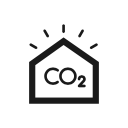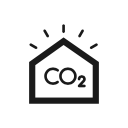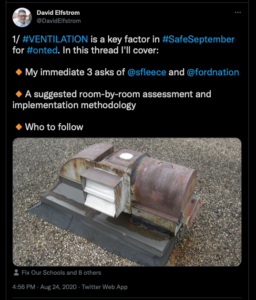Introduction
It's May, 14, 2021 and the consensus is that COVID is airborne, that the characteristics of aerosols play a significant role in how it spreads and infects. This is distinct from the outdated assumption that it is spread primarily through droplets and/or surface contact (foamites).
 Summary: Add CO2 Sensors to our Classrooms & Offices to verify healthy ventilation
Summary: Add CO2 Sensors to our Classrooms & Offices to verify healthy ventilation
I am advocating for the addition of CO2 sensors to all classrooms and offices in our schools. Carbon Dioxide (CO2) measurement is commonly used by ventilation experts to determine the "freshness" of air. More on this below.

Excerpt from a letter to Prime Minister Boris Johnson.
Actions to Take in our Schools
Beyond distancing, masking and vaccination, we need to focus on airflow in the indoor spaces where people congregate: schools, offices, factories, distribution centres, etc. Here I'm going to focus on school settings, whether at the elementary/secondary or post-secondary.
The reason we need to focus on airflow is that it is clear that there will be a non-negligible number of people entering our schools who will either refuse to or cannot mask, distance or vaccinate. Some may do so for sincere and truthful reasons, while others may hide or lie about their status or motivations. Regardless, verifying the COVID status of individuals will likely be impossible or impractical. So we must examine passive methods for minimizing the threat of COVID in these indoor environments. Ventilation is perhaps the best candidate for this as it is unintrusive and universally applicable using mundane, proven, off-the-shelf technologies and techniques, as described in this interview and associated Twitter thread.
 Ventilation Improvements
Ventilation Improvements
Anybody that has been in a typical Canadian primary or secondary school in the middle of June knows how terrible the ventilation is. While adding stand-alone fans and air filters in the classroom was a good ad-hoc approach in 2020 when we were coming to grips with the reality of COVID, it is no longer acceptable as the only way to improve ventilation.
Properly designed and installed HVAC (Heating Ventilation and Cooling) systems, capable of exchanging "dirty" air for fresh, outside air is necessary. Nothing short of this is acceptable if our goal is to reopen our schools -- and therefore our economies -- in September 2021.
But installation of HVAC is not sufficient. We need to monitor, in real time, the status of the air in our classrooms to ensure that when the ventilation fails we can be alerted to that fact and then act to keep our children and schools staff safe.
Therefore, we need to measure the quality of the air in our classrooms.
Ventilation Verification: CO2 Sensors
I am advocating for the addition of CO2 sensors to all classrooms and offices in our schools. Carbon Dioxide (CO2) measurement is commonly used by ventilation experts to determine the "freshness" of air. The consensus is that a level of CO2 between 400 and 800 ppm (parts per million) is the threshold for acceptable fresh air (sources: 1, 2, 3, 4, 5).
CO2 sensors are inexpensive, easy to install and operate. Many look like the thermostats that we see in homes, schools and offices. There are many sources of CO2 sensors, including:
These sensors are cheap. They're available now. They're easy to install. They do the job. We should install them in every classroom, in every communal indoor space. In doing so we will be able to help everyone make informed decisions about how and when to use indoor spaces safely.
[Note: CO2 sensors measure Carbon Dioxide. These are different than the normal Carbon Monoxide (CO) sensors that many of us already have in our homes alongside our smoke detectors. CO2 sensors measure the safe gases we breathe out to indicate how fresh air is, while the other kind of sensor measures dangerous CO gas.]
Conclusion
The actions we take in the Summer of 2021 are going to be key in the fight against COVID in a bid to reopen our schools and economies. Installing ventilation systems in indoor spaces that can keep CO2 levels low and providing occupants with the means to verify in realtime that this is the case are key to making this happen.
Background Evidence
Here is a snapshot of the current thinking on COVID and its aerosol characteristics:
Scientific, Peer-reviewed Articles & Reports
- Greenhalgh, Trisha, et al. "Ten scientific reasons in support of airborne transmission of SARS-CoV-2." The Lancet 397.10285 (2021): 1603-1605.
- Baraniuk, Chris. "Covid-19: What do we know about airborne transmission of SARS-CoV-2?." bmj 373 (2021).
- Tang, Julian W., et al. "Dismantling myths on the airborne transmission of severe acute respiratory syndrome coronavirus (SARS-CoV-2)." Journal of Hospital Infection(2021).
- Pease, Leonard F., et al. "Investigation of potential aerosol transmission and infectivity of SARS-CoV-2 through central ventilation systems." Building and Environment (2021): 107633.
- Related list of scientific papers @ Masks4Canada.
Popular Media Articles
- Molteni, Mega. "The 60-Year-Old Scientific Screwup That Helped Covid Kill." Wired (May 2021)
- Fallis, Brooks and Fisman, David. "Embracing the science on airborne transmission is key to preventing new COVID-19 outbreaks." The Globe and Mail (May 2021)
- Jimenez, Jose-Luis. "COVID-19 is Transmitted Through Aerosols. We Have Enough Evidence, Now it is Time to Act." New York Times (August, 2020)
- Hafner, Katherine. "Virginia scientist thinks measuring CO2 is key to safely reopening schools, businesses." The Virginian-Pilot (Feb, 2021)
- O'Shea, Joe. "UCC prof teams up with Cork hairdresser to show how businesses can stop the spread of the virus" CorkBeo (May 2021)
- Mojtehedzadeh, Sarah. "How a COVID-19 Blind Spot put Ontario's Essential Workplaces at Risk" The Toronto Star (May, 2021) [David Fisman's thread on Twitter]
Professional Organizations & Government Documents
- The Ontario Society of Professional Engineer's (OSPE) statement on COVID: "Engineers call on Ontario to refocus efforts on the airborne transmission of COVID-19". OSPE Website (Jan. 2021). [David Elfstrom's comments on Twitter]
- Government of Canada Public Health: "Influence of ventilation on risk of aerosol transmission (COVID-19 Guidance on indoor ventilation during the pandemic)" (updated Jan. 18 2021) [David Elfstrom's comments on Twitter]
- Gettings, Jenna, et al. "Mask Use and Ventilation Improvements to Reduce COVID-19 Incidence in Elementary Schools — Georgia, November 16–December 11, 2020." CDC Morbidity and Mortality Weekly Report (May 2021). [Thread on Twitter]
- Kinnair, Donna, et al. "Re: Protecting health care workers - better ventilation, PPE, awareness and research" (Letter to P.M. Boris Johnson) (February 2021).
Other
- Jimenez et al. "FAQs on Protecting Yourself from COVID-19 Aerosol Transmission." December 2020. (background articles: 1 and 2)
- The COVID CO2 Tracker.
- Thread on outside air and schools by Dr. Marwa Zaatari. Related thread 1 and 2.
- Mask4Canada open letter (en / fr) ; signature pages (en / fr)
- Classroom resources related to ventilation.
James Andrew Smith is an associate professor in Electrical Engineering and Computer Science Department in York University's Lassonde School. He lived in Strasbourg, France and taught at the INSA Strasbourg and Hochschule Karlsruhe while on sabbatical in 2018-19 with his wife and kids.



